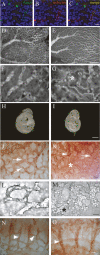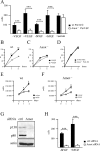Angiomotin regulates endothelial cell migration during embryonic angiogenesis
- PMID: 17699752
- PMCID: PMC1948860
- DOI: 10.1101/gad.432007
Angiomotin regulates endothelial cell migration during embryonic angiogenesis
Abstract
The development of the embryonic vascular system into a highly ordered network requires precise control over the migration and branching of endothelial cells (ECs). We have previously identified angiomotin (Amot) as a receptor for the angiogenesis inhibitor angiostatin. Furthermore, DNA vaccination targeting Amot inhibits angiogenesis and tumor growth. However, little is known regarding the role of Amot in physiological angiogenesis. We therefore investigated the role of Amot in embryonic neovascularization during zebrafish and mouse embryogenesis. Here we report that knockdown of Amot in zebrafish reduced the number of filopodia of endothelial tip cells and severely impaired the migration of intersegmental vessels. We further show that 75% of Amot knockout mice die between embryonic day 11 (E11) and E11.5 and exhibit severe vascular insufficiency in the intersomitic region as well as dilated vessels in the brain. Furthermore, using ECs differentiated from embryonic stem (ES) cells, we demonstrate that Amot-deficient cells have intact response to vascular endothelial growth factor (VEGF) in regard to differentiation and proliferation. However, the chemotactic response to VEGF was abolished in Amot-deficient cells. We provide evidence that Amot is important for endothelial polarization during migration and that Amot controls Rac1 activity in endothelial and epithelial cells. Our data demonstrate a critical role for Amot during vascular patterning and endothelial polarization.
Figures







Similar articles
-
Angiomotin-like protein 1 controls endothelial polarity and junction stability during sprouting angiogenesis.Circ Res. 2009 Jul 31;105(3):260-70. doi: 10.1161/CIRCRESAHA.109.195156. Epub 2009 Jul 9. Circ Res. 2009. PMID: 19590046
-
Therapeutic antibodies targeting angiomotin inhibit angiogenesis in vivo.FASEB J. 2008 Mar;22(3):880-9. doi: 10.1096/fj.07-9509com. Epub 2007 Nov 5. FASEB J. 2008. PMID: 17984175
-
The Amot/Patj/Syx signaling complex spatially controls RhoA GTPase activity in migrating endothelial cells.Blood. 2009 Jan 1;113(1):244-53. doi: 10.1182/blood-2008-04-153874. Epub 2008 Sep 29. Blood. 2009. PMID: 18824598 Free PMC article.
-
Role of the vascular endothelial growth factor isoforms in retinal angiogenesis and DiGeorge syndrome.Verh K Acad Geneeskd Belg. 2005;67(4):229-76. Verh K Acad Geneeskd Belg. 2005. PMID: 16334858 Review.
-
Transgenic mouse models of angiogenesis and lymphangiogenesis.Int Rev Cell Mol Biol. 2008;266:1-35. doi: 10.1016/S1937-6448(07)66001-8. Int Rev Cell Mol Biol. 2008. PMID: 18544491 Review.
Cited by
-
Amot130 adapts atrophin-1 interacting protein 4 to inhibit yes-associated protein signaling and cell growth.J Biol Chem. 2013 May 24;288(21):15181-93. doi: 10.1074/jbc.M112.446534. Epub 2013 Apr 5. J Biol Chem. 2013. PMID: 23564455 Free PMC article.
-
The polarity protein Angiomotin p130 controls dendritic spine maturation.J Cell Biol. 2018 Feb 5;217(2):715-730. doi: 10.1083/jcb.201705184. Epub 2018 Jan 9. J Cell Biol. 2018. PMID: 29317530 Free PMC article.
-
Faulty oxygen sensing disrupts angiomotin function in trophoblast cell migration and predisposes to preeclampsia.JCI Insight. 2019 Apr 18;4(8):e127009. doi: 10.1172/jci.insight.127009. eCollection 2019 Apr 18. JCI Insight. 2019. PMID: 30996134 Free PMC article.
-
Reverse genetic screening reveals poor correlation between morpholino-induced and mutant phenotypes in zebrafish.Dev Cell. 2015 Jan 12;32(1):97-108. doi: 10.1016/j.devcel.2014.11.018. Epub 2014 Dec 18. Dev Cell. 2015. PMID: 25533206 Free PMC article.
-
The Amotl2 gene inhibits Wnt/β-catenin signaling and regulates embryonic development in zebrafish.J Biol Chem. 2012 Apr 13;287(16):13005-15. doi: 10.1074/jbc.M112.347419. Epub 2012 Feb 23. J Biol Chem. 2012. PMID: 22362771 Free PMC article.
References
-
- Aepfelbacher M., Essler M., Huber E., Sugai M., Weber P.C., Essler M., Huber E., Sugai M., Weber P.C., Huber E., Sugai M., Weber P.C., Sugai M., Weber P.C., Weber P.C. Bacterial toxins block endothelial wound repair. Evidence that Rho GTPases control cytoskeletal rearrangements in migrating endothelial cells. Arterioscler. Thromb. Vasc. Biol. 1997;17:1623–1629. - PubMed
-
- Balconi G., Spagnuolo R., Dejana E., Spagnuolo R., Dejana E., Dejana E. Development of endothelial cell lines from embryonic stem cells: A tool for studying genetically manipulated endothelial cells in vitro. Arterioscler. Thromb. Vasc. Biol. 2000;20:1443–1451. - PubMed
-
- Berglin L., Sarman S., van der Ploeg I., Steen B., Ming Y., Itohara S., Seregard S., Kvanta A., Sarman S., van der Ploeg I., Steen B., Ming Y., Itohara S., Seregard S., Kvanta A., van der Ploeg I., Steen B., Ming Y., Itohara S., Seregard S., Kvanta A., Steen B., Ming Y., Itohara S., Seregard S., Kvanta A., Ming Y., Itohara S., Seregard S., Kvanta A., Itohara S., Seregard S., Kvanta A., Seregard S., Kvanta A., Kvanta A. Reduced choroidal neovascular membrane formation in matrix metalloproteinase-2-deficient mice. Invest. Ophthalmol. Vis. Sci. 2003;44:403–408. - PubMed
-
- Bostrom H., Willetts K., Pekny M., Leveen P., Lindahl P., Hedstrand H., Pekna M., Hellstrom M., Gebre-Medhin S., Schalling M., Willetts K., Pekny M., Leveen P., Lindahl P., Hedstrand H., Pekna M., Hellstrom M., Gebre-Medhin S., Schalling M., Pekny M., Leveen P., Lindahl P., Hedstrand H., Pekna M., Hellstrom M., Gebre-Medhin S., Schalling M., Leveen P., Lindahl P., Hedstrand H., Pekna M., Hellstrom M., Gebre-Medhin S., Schalling M., Lindahl P., Hedstrand H., Pekna M., Hellstrom M., Gebre-Medhin S., Schalling M., Hedstrand H., Pekna M., Hellstrom M., Gebre-Medhin S., Schalling M., Pekna M., Hellstrom M., Gebre-Medhin S., Schalling M., Hellstrom M., Gebre-Medhin S., Schalling M., Gebre-Medhin S., Schalling M., Schalling M., et al. PDGF-A signaling is a critical event in lung alveolar myofibroblast development and alveogenesis. Cell. 1996;85:863–873. - PubMed
-
- Bratt A., Wilson W.J., Troyanovsky B., Aase K., Kessler R., Van Meir E.G., Holmgren L., Wilson W.J., Troyanovsky B., Aase K., Kessler R., Van Meir E.G., Holmgren L., Troyanovsky B., Aase K., Kessler R., Van Meir E.G., Holmgren L., Aase K., Kessler R., Van Meir E.G., Holmgren L., Kessler R., Van Meir E.G., Holmgren L., Van Meir E.G., Holmgren L., Holmgren L. Angiomotin belongs to a novel protein family with conserved coiled-coil and PDZ binding domains. Gene. 2002;298:69–77. - PubMed
Publication types
MeSH terms
Substances
LinkOut - more resources
Full Text Sources
Other Literature Sources
Molecular Biology Databases
Research Materials
